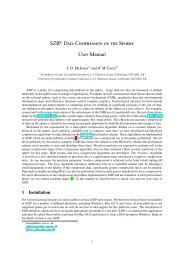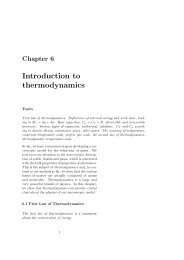Bayesian Methods for Astrophysics and Particle Physics
Bayesian Methods for Astrophysics and Particle Physics
Bayesian Methods for Astrophysics and Particle Physics
Create successful ePaper yourself
Turn your PDF publications into a flip-book with our unique Google optimized e-Paper software.
1.5 Comparing Data–Sets<br />
would point towards tension between constraints, which prefer different regions<br />
of model parameter space.<br />
In order to motivate the use of <strong>Bayesian</strong> evidence to quantify the consistency<br />
between different data-sets we apply the method to the classic problem of fitting<br />
a straight line through a set of data points.<br />
1.5.1 Toy Problem<br />
We consider that the true underlying model <strong>for</strong> some process is a straight line<br />
described by:<br />
y(x) = mx + c, (1.16)<br />
where m is the slope <strong>and</strong> c is the intercept. We take two independent sets of<br />
measurements D1 <strong>and</strong> D2 each containing 5 data points. The x value <strong>for</strong> all these<br />
measurements are drawn from a uni<strong>for</strong>m distribution U(0, 1) <strong>and</strong> are assumed to<br />
be known exactly.<br />
1.5.1.1 Case I: Consistent Data-Sets<br />
In the first case we consider m = 1, c = 1 <strong>and</strong> add Gaussian noise with st<strong>and</strong>ard<br />
deviation σ1 = 0.1 <strong>and</strong> σ2 = 0.1 <strong>for</strong> data-sets D1 <strong>and</strong> D2 respectively. Hence<br />
both the data-sets provide consistent in<strong>for</strong>mation on the underlying process.<br />
We assume that the errors σ1 <strong>and</strong> σ2 on the data-sets D1 <strong>and</strong> D2 are known<br />
exactly. The likelihood function can then be written as:<br />
where<br />
<strong>and</strong><br />
L(m, c) ≡ P(D|m, c, H) = <br />
P(Di|m, c, H), (1.17)<br />
P(Di|m, c, H) =<br />
i<br />
1<br />
2πσ 2 i<br />
where ˜y(xj) is the predicted value of y at a given xj.<br />
exp[−χ 2 i/2] (1.18)<br />
χ 2 i = (y(xj) − ˜y(xj)) 2<br />
. (1.19)<br />
j<br />
We impose uni<strong>for</strong>m, U(0, 2) priors on both m <strong>and</strong> c. In Figure 1.1 we show the<br />
data points <strong>and</strong> the posterior <strong>for</strong> the analysis assuming the data-sets D1 <strong>and</strong> D2<br />
7<br />
σ 2 i






